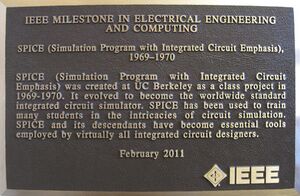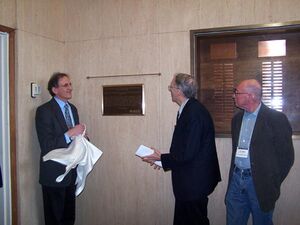Milestones:SPICE (Simulation Program with Integrated Circuit Emphasis), 1969-1970
- Date Dedicated
- 2011/02/20
- Dedication #
- 111
- Location
- Berkeley, CA, U.S.A.
- IEEE Regions
- 6
- IEEE sections
- Santa Clara Valley, Oakland-East Bay
- Achievement date range
- 1971-1970
Citation
SPICE (Simulation Program with Integrated Circuit Emphasis) was created at UC Berkeley as a class project in 1969-1970. It evolved to become the worldwide standard integrated circuit simulator. SPICE has been used to train many students in the intricacies of circuit simulation. SPICE and its descendants have become essential tools employed by virtually all integrated circuit designers.
Street address(es) and GPS coordinates
- Site 1: 253 Cory Hall: on the University of California-Berkeley campus southeast of the corner of Hearst Ave. and LeRoy Ave., Berkeley CA 94720 US (GPS: 37.875303, -122.257389).
- Site 2: Computer History Museum, 1401 N. Shoreline Blvd, Mountain View, CA 94043 US (GPS: 37.414757, -122.077679).
Details of the physical location of the plaque
- Site 1: On the righthand wall just inside the main entrance to Cory Hall.
- Site 2: On the inside face of the front patio brick wall, near the Main Entrance.
How the intended plaque site is protected/secured
- Site 1: Cory Hall is a UC Berkeley building of lecture halls and classrooms which houses the Electrical Engineering Division and EECS Department offices, and is also where the first three versions of SPICE were developed. Building security is provided by the University of California Police.
- Site 2: Building security; 24/7 access.
Historical Significance
SPICE was the first computer program for simulating the performance of integrated circuits that was readily available to undergraduate students for study of integrated circuit design. Hundreds of graduates from UC Berkeley and other universities became the backbone of the engineering workforce that moved the US to microelectronics to industry leadership in the 1970s. Graduates of Berkeley became leaders of today's largest firms delivering design automation capabilities for advanced microelectronics.
SPICE was much more than a simple program for instructional use. It was the first to incorporate sparse matrix analysis to permit economic simulation of large circuits, adjoint analysis for sensitivity to component variations and noise, built-in device models for "first-cut" design, and a simple user interface that evolved through the transitions from punched cards to dumb terminals to sophisticated workstations. For the first time, the developers of SPICE made source code widely available, enabling others to contribute more sophisticated device models and additional analysis capabilities. These factors contributed to its dominant status in the subsequent development of both open-source and proprietary circuit simulation software.
Dedication ceremony
References and Further Reading
[1] L. W. Nagel, “CANCER: Computer Analysis of Nonlinear Circuits Excluding Radiation,” Masters Report, Dept of EECS, Univ. of California, Berkeley, CA, December 11, 1970.
[2] R. A. Rohrer, L. W. Nagel, R. Meyer, and L. Weber, “CANCER: Computer Analysis of Nonlinear Circuits Excluding Radiation,” 1971 IEEE Intl Solid-State Circuit Conference, Philadelphia, PA, February 18, 1971, pp. 124-125.
[3] L. Nagel and R. Rohrer, "Computer Analysis of Nonlinear Circuits, Excluding Radiation (CANCER)," IEEE J Solid-State Circuits, Vol SC-6, No 4, August 1971, pp. 166-182.
[4] L. W. Nagel and D. O. Pederson, “Simulation Program with Integrated Circuit Emphasis (SPICE),” presented at 16th Midwest Symp. on Circuit Theory, Ontario, Canada, April 12, 1973 and available as Memorandum No ERL-M382, Electronics Research Laboratory, College of Engineering, University of California, Berkeley, CA, www.eecs.berkeley.edu/Pubs/TechRpts/1973/ERL-382.pdf
[5] L. W. Nagel, “SPICE2: A Computer Program to Simulate Semiconductor Circuits,” PhD dissertation, Univ. of California, Berkeley, CA, May 9 1975 and available as Memorandum No ERL-M520, Electronics Research Laboratory, College of Engineering, University of California, Berkeley, CA, www.eecs.berkeley.edu/Pubs/TechRpts/1975/ERL-520.pdf.
[6] E. Cohen, “Program Reference for SPICE2,” University of California, Berkeley, ERL Memo UCB/ERL M75/520, May 1975, www.eecs.berkeley.edu/Pubs/TechRpts/1976/ERL-592.pdf.
[7] A. Vladimeriscu and S. Liu, “The Simulation of MOS Integrated Circuits Using SPICE2,” University of California, Berkeley, UCB/ERL M80/7, October 1980, www.eecs.berkeley.edu/Pubs/TechRpts/1980/ERL-80-7.pdf.
[8] A. Vladimirescu, K. Zhang, A. R. Newton, D. O. Pederson and A. L. Sangiovanni- Vincentelli, “SPICE Version 2G User’s Guide,” Dept. of EECS, University of California, Berkeley, August 1981.
[9] T. L. Quarles, “Analysis of Performance Issues and Convergence in Circuit Simulation,” University of California, Berkeley, ERL Memo UCB/ERL M89/42. April 1989, [www.eecs.berkeley.edu/Pubs/TechRpts/1980/ERL-80-7.pdf].
[10] T. L. Quarles, “SPICE3 Version 3C1 User’s Guide,” University of California, Berkeley, ERL Memo UCB/ERL M89/46, April 1989, [www.eecs.berkeley.edu/Pubs/TechRpts/1989/ERL-89-46.pdf]
[11] Laurence W. Nagel: "The Origins of SPICE"
[12] Laurence W. Nagel: "The Life of SPICE" - June 2009 presentation to the IEEE Consultants' Network of Silicon Valley (IEEE-CNSV)
[13] Daniel Payne: "A Brief History of SPICE"
Letter from the site owner giving permission to place IEEE milestone plaque on the property
SPICE Milestone Support Letter
Historical references for SPICE.pdf
Proposal and Nomination
Milestone-Proposal:Birthplace of the SPICE Circuit Simulation Program, 1971
Milestone-Nomination:Birthplace of the SPICE Circuit Simulation Program, 1971


